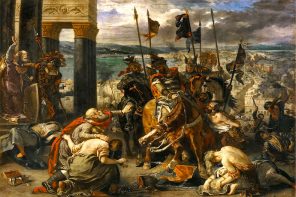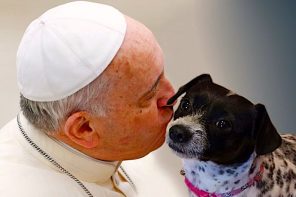Like many areas in American life, the symbols of Christmas are haunted by the specter of race hovering in the background. Personally, I’m totally comfortable with Santa Claus being depicted as white, not because I believe that Santa is “really white,” but because, for me, this just isn’t a battle I’m willing to wage in the name of diversity and representation.
That said, I totally understand why it’s important that millions of Black children are exposed to a predominantly or exclusively Black Santa in their homes. It’s perfectly understandable after all for parents to have their children associate Santa with their own cultural background. And as a fictional character there’s no valid reason that Santa cannot be depicted as Black.
In the hip hop remake of Eartha Kitt’s “Santa Baby” by The Christmas Allstars, Snoop Dogg offers the following criticism on the futility of believing in a white Santa Claus as a Black child in the hood:
Cookies and milk
Satin and silk
I’m chillin in the living room, wrapped in a quilt
I’m waiting on this fat red suit wearing-comparing
My gifts to my homeboy next door to me
A gift here, none there, but who cares
My little sister needs a comb just to braid her nappy hair
But here we go again waiting on the enemy
To slide down the chimney
Look here, that ain’t reality
Clearly, Snoop is referencing the traditional depiction of Santa as white as “the enemy.” A similar suspicion in the song is uttered by rapper Keith Murray who describes his encounter with Santa in the hood and the reality that his gifts were the product of a Black mother rather than a beneficent white man:
On December 25th I knew I wasn’t getting jack
When I saw Santa Claus on the corner buying crack
I ran up on him with the Cadillac and asked him “yo what’s up with that?”
He said “There ain’t no Christmas kid” and I can’t get him back
Back in the days, Christmas was deep
My moms put presents under the tree while I played sleep
And peeped ha! Santa Claus never gave me nuthin
Seen them mad faces, lying and frontin
So do some good to the ghetto, Mr. Chris Kringle
Come and stay awhile, kick it with god’s angel
Take and acknowledge my wisdom and understand
That Santa Claus is a black man
Word up
While the goal of creating a culturally representative depiction is important, I think it contains a fundamental flaw in terms of race and self-perception. It’s not totally clear that the depiction of Santa Claus (or even divine figures like angels and Jesus Christ) as Black precedes the formation of an affirming self-identity. Simply put: just because a Black child grows up with depictions of Santa as Black it doesn’t necessarily translate to a positive and healthy self-image.
How Santa got to the North Pole
Many are familiar with the origins of Santa Claus being tied to St. Nicholas of Myra, a region in Turkey. After losing his parents at a young age Nicholas used his inheritance to assist the needy, the sick, and the suffering. He dedicated his life to serving God and was made Bishop of Myra while still a young man. Bishop Nicholas became known throughout the land for his generosity to those in need, his love for children, and his concern for sailors and ships.
In America most of our popular conceptions of Santa Claus, however, can be traced to 1823 when the poem “A Visit from St. Nicholas” (aka “The Night Before Christmas”) was published in the Troy Sentinel. By 1863, Thomas Nast’s illustrations of Saint Nicholas, or “Santa Claus,” as a white, bearded, heavy-set figure appeared in Harper’s Weekly essentially cementing our imaginary depictions of Santa Claus.
It was also during the latter half of the 19th century that much of the Santa Claus mythology took root, including his North Pole residence. During the 20th century, ad campaigns by competing soda drink companies Coca-Cola, Pepsi-Cola, and White Rock Beverages all depicted Santa Claus in his now iconic red and white suit. That said, Santa Claus was not exclusively depicted as white in the popular American imagination.
In his BBC News piece, “Secret History of Black Santas,” Brian Wheeler uncovers a long tradition of depicting ol’ St. Nick as Black as far back as the turn of the 20th century. Unfortunately, rather than function as attempts at inclusion and diversity these early depictions were tainted by the practice of blackface and minstrelsy that relegated African Americans to grotesque stereotypes.
As the 20th century progressed ‘Black Santas’ were largely concentrated in African-American communities such as Harlem. For example, famed tap dancer Bill “Bojangles” Robinson suited up as Santa Claus in 1936 in Harlem for a children’s party. By the time of the Civil Right Movement, Black Santa became one of the many symbols of integration as groups like the Southern Christian Leadership Conference (SCLC) pushed for the inclusion of Black men to appear as Santa Claus in prominent department stores such as Macy’s. By the 1970s and 80s, the practice of racially diverse depictions of Santa Claus was becoming increasingly more common and less controversial.
However, this Santa Claus diversity would become an innocent bystander of the conservative cultural backlash against the election of the first Black president, Barack Obama, and the purported ‘post-racialism’ his election represented. In response to a 2013 Slate piece titled, “Santa Claus Should Not Be a White Man Anymore,” former Fox News commentator Megyn Kelly ‘went to the mattresses’ in defense of the supposed whiteness of both Santa and Jesus as historical figures.
In 2016, the decision by the Mall of America to host their first Black Santa in the mall’s history initially received a positive response, only later to be met with scorn and backlash on social media. Although African Americans have long depicted Santa Claus as Black, the depiction of Santa as Black seemed, to many, to signal the continued excesses of political correctness and the decline of white normativity in American cultural symbolism.
Along with the fictional “War on Christmas,” there appears to be a campaign to ‘Make Santa White Again’ as in the recent case of an African-American family in North Little Rock, Arkansas who received a racist message from a white neighbor for displaying a Black Santa on their lawn. In response to this act of hate, neighbors supported the family with Black Santa decorations throughout the neighborhood as an act of solidarity.
When Black childhoods matter
Some believe that diversifying symbols like Santa Claus can assist us in creating a more inclusive and tolerant society. I think this is illusory at best and reinscribes whiteness at its worst. A white Santa for whites, a Black Santa for Blacks, and so on, doesn’t change the racial hierarchy. We never refer to white Santa as “white Santa,” he’s just Santa Claus. Because of anti-black racism, Black Santa isn’t simply Santa Claus, but “Black Santa,” an inferior or imitation version.
When some Black parents (or as Heather Tirado Gilligan experienced in “I’m Dreaming Of A Less White Christmas For My Child of Color”) insist on a Black Santa their perceptive children quickly retort “Santa is white.” This means that these children of color have already imbibed the normalcy of whiteness. This was most famously reflected in the “doll test” developed by Kenneth and Mamie Clark as evidence of the harmful effects of Jim Crow segregation. The results of this experiment were used by the NAACP-Legal Defense Fund in its challenge to separate-but-equal education in the Brown v. Board case.
In 2006, a similar study showed African-American children still labeling a Black doll “bad.” Both ABC, in 2009, and CNN’s Anderson Cooper in 2010, replicated the doll test for a national audience. The results of the contemporary test were used to discuss the effects of living in a racist society on Black children even with an abundance of Black Santas, Black dolls, diverse television programing, and a Black president.
I’m not arguing for the elimination of Black Santa, or Wakandan-inspired Christmas stories, such as the recent Netflix sensation Jingle Jangle. Representation is important—particularly for children. Representation alone, however, doesn’t negate the effects of racism regardless of whether it’s the first Black president, first Black woman vice-president or even if it’s sitting on the knee of a Black Santa Claus.
Black children are routinely victims of early criminalization and adultification from their teachers, peers, and society, often for the same behaviors as white children. Therefore along with increased inclusion and representation, the ongoing racial disparities and criminal justice issues that disproportionately affect Black children must be addressed at the local, state, and federal level. When as a society we decide that Black childhoods matter, we will, in the spirit of St. Nicholas, protect and value Black children.





